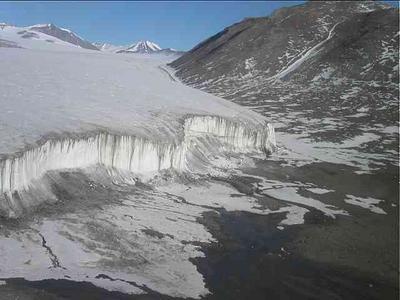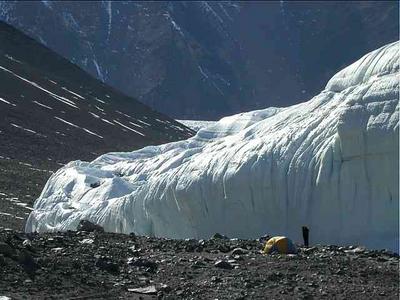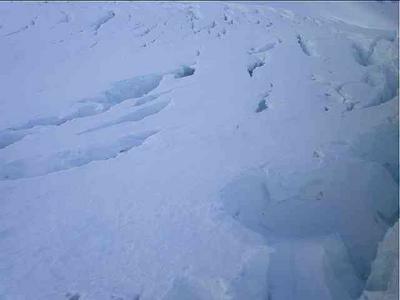22 January, 2003
Glaciers in Antarctica
Antarctica is a desert and the driest place on earth, but the
Antarctic ice sheet has an area of about 13.3 million square miles.
This enormous amount of ice has accumulated over millions of years
with very little melt. It provides a natural laboratory for
scientists to study evidence of past climates and environments.
In the Dry Valleys, scientists are studying glaciers in an attempt
to measure the mass balance of the glaciers and to relate these data
sets with the other hydrological processes including the lakes and
streams. The mass of the glacier is balanced when the amount of ice
accumulating is equal to the ice that is ablating. (Ablation means
the loss of ice through melting or sublimating. Sublimation is the
process where the ice changes state from a solid to a gas without
melting first.) Understanding the glacier-climate connection today
may help unravel mysteries of the past, including ancient Lake
Washburn that used to fill Taylor Valley.
To calculate the mass balance of a glacier, or how much ice and
snow is lost or gained, scientists place bamboo poles, or ablation
stakes, on top of the glacier and then measure from the top of the
stake to the surface of the ice twice a season in November and
January. They are able to calculate the loss of ice and the gain of
snow accumulation.
Andrew Fountain is the PI (principal investigator) from Portland
State University who heads the glacier team. This year Thomas Nylen,
also from PSU, is leading the studies and data collection in the
field and is assisted by Amy Ebnet, a graduate student from PSU.
Thomas told me that Antarctic glaciers are different from others
in the world in a several ways. Moraines of Antarctic glaciers are
not usually as big as other alpine glaciers in the mid latitudes.
Lateral and terminal moraines are where the glacier has dropped rocks
from its surface down its sides. Glaciers act as a conveyor belt,
transporting rocks down from higher locations. Rocks dropped on top
of the glacier slowly move along with the ice as it travels.
Eventually they are dropped in front of the glacier. If the glacier
retreats, you may see several different terminal moraines.
Another way they are different is in their ablation rates.
Antarctic glaciers ablate about 30 cm a year, while other places in
the world ablate that much in a day! Last year, the glaciers ablated
about one meter because of the warm temperatures AND the amount of
solar radiation. Solar radiation is an important variable. For
example, yesterday the temperature was above freezing, but there was
a heavy cloud cover and little solar radiation. The streams stopped
flowing because the melt from the glaciers was low.
An additional difference between Antarctic glaciers and other
glaciers in the world is the ratio of ablation. Antarctic glaciers
generally ablate in a ratio of 30% melt and 70% sublimation, whereas
other glaciers have almost the exact opposite ratio. Along the face
of the glacier there is a higher percentage of melt.
An interesting feature on the dry valley glaciers, which also
occurs in other parts of the world, is cryoconite holes. When
sediment falls on the top of the glacier, it is a darker color than
the ice so it absorbs more solar radiation. As it heats up, the
sediment melts down 10s of centimeters below the ice surface. Often
algae, rotifers, and tardigrades exist in the cryoconite holes. This
is just another testament to water bringing forth life, sometimes in
amazingly remote and harsh places. Nematodes have not been found in
these holes, mainly because there is too much water.

1. Amy and Thomas visit us for lunch at F6.

2. Flying over the CommonwealthGlacier.

3. The Canada Glacier by Lake Hoare.

4. Top of the Canada Glacier, showing deep crevasses.
Contact the TEA in the field at
.
If you cannot connect through your browser, copy the
TEA's e-mail address in the "To:" line of
your favorite e-mail package.
|
